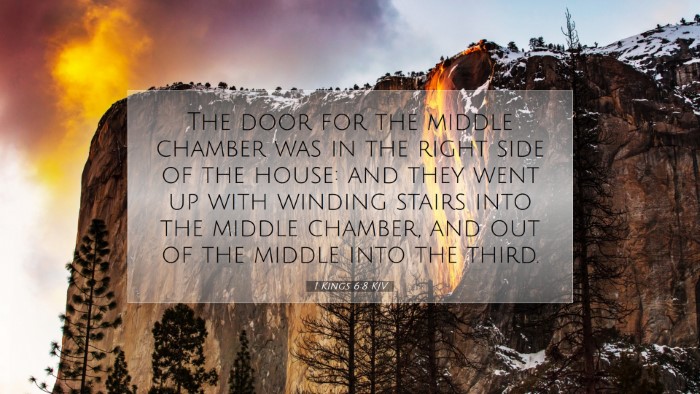Commentary on 1 Kings 6:8
1 Kings 6:8 states, "The door for the middle chamber was in the right side of the house: they went up with winding stairs into the middle chamber, and out of the middle chamber to the third." This verse describes an architectural feature of Solomon's temple, which is significant not only for its construction details but also for the spiritual implications and theological themes it signifies.
Architectural Significance
Understanding the architectural layout of the temple offers insight into its symbolic meaning. The mention of "the door for the middle chamber" indicates careful planning and design. Early Jewish tradition emphasizes God’s providential guidance in the construction of the temple. The chamber referenced was presumably meant for priests or sacred functions, linking the physical structure to spiritual worship.
- Matthew Henry elaborates on the temple's design emphasizing its spiritual purpose: that every part serves to elevate the act of worship.
- Adam Clarke notes the significance of the 'winding stairs' as a metaphor for the journey one takes in approaching and understanding God — suggesting spiritual ascent and enlightenment.
Spiritual Implications
Albert Barnes interprets this architectural detail as more than just a structural element; it is a representation of the journey to God. The winding stairs symbolize the complex path we navigate in our spiritual life, indicating that access to God requires effort and commitment.
Moreover, the mention of a door implies that access is regulated. This may symbolize the exclusivity of God’s presence, reminding believers of the need for holiness and righteousness to approach Him. The middle chamber, therefore, serves as a vital space where humans may encounter the divine.
Theological Themes
Several theological themes arise from this verse:
- Holiness of God: The design reflects divine holiness and the need for separation from the common in worship.
- Covenant Relationship: The chambers can be seen as emblematic of different aspects of the covenant relationship between God and His people, implying levels of intimacy and revelation.
- Access and Mediation: The existence of doors and chambers indicates that while access to God is available, it is mediated through sacred means such as priests and rituals.
Practical Applications
For modern believers, the lessons from 1 Kings 6:8 can be profound:
- Preparation for Worship: Like the careful design of the temple, believers are called to prepare their hearts and minds for worship. This verse calls for intentionality in our approach to God.
- Spiritual Growth: The winding stairs signify that spiritual growth is often gradual and requires perseverance. Believers are encouraged to pursue deeper understanding and relationship with God.
- Holiness in Approach: The notion that access to God necessitates a certain reverence and holiness prompts believers to examine their lives and practices to align with the standards of worship.
Conclusion
In conclusion, 1 Kings 6:8, while a seemingly simple verse about the structure of Solomon's temple, carries with it profound implications for understanding God’s nature, the process of worship, and the believer’s journey. For theologians, pastors, and scholars, this verse invites deeper reflection on how we approach God and the importance of the holy spaces in our lives, both physical and spiritual.


